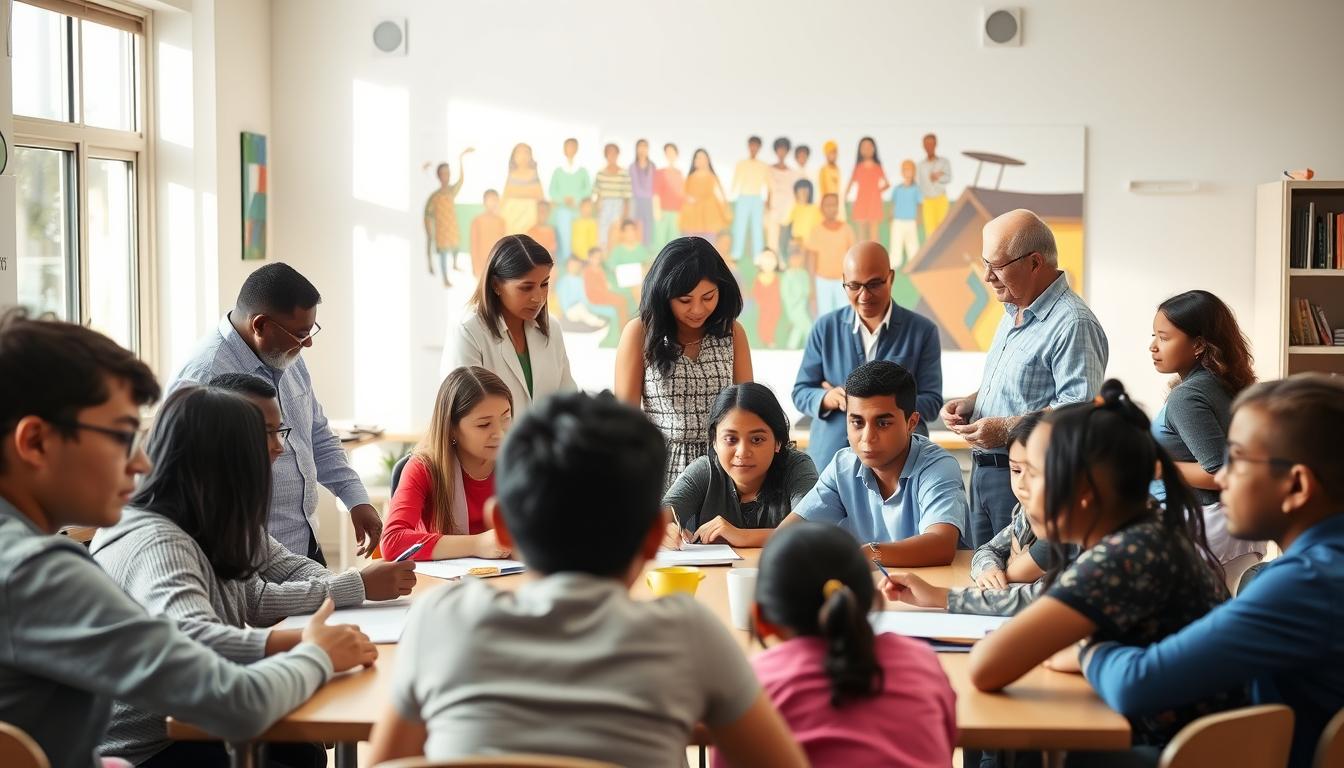The Importance of Bilingual Education: Advantages for Immigrant Children
Bilingual education is key for immigrant kids in the U.S. It helps them in school and with friends. Learning two languages boosts their thinking skills and grades. It also makes them feel better emotionally.
Also, bilingual education keeps cultural ties strong. It makes communities more welcoming and diverse. Knowing how important bilingual education is helps make schools fairer for everyone.
Understanding Bilingual Education
Bilingual education is key in shaping education for many students. It lets people learn in two languages, boosting their language and thinking skills. Knowing what bilingual education is helps schools support students from different backgrounds.
Definition of Bilingual Education
Bilingual education means learning in more than one language. It helps students learn new languages and keeps their cultural roots strong. This way, bilingualism is seen as a plus, not a problem.
Types of Bilingual Education Programs
There are many bilingual education programs, each for different needs. Some common ones are:
- Transitional bilingual education
- Developmental bilingual education
- Dual language immersion programs
These programs have different goals and ways to teach. They focus on improving language skills and helping students succeed in school.
Importance of Cultural Context
Cultural context is very important in bilingual education. It shapes how language and identity blend in school. Programs that honor and celebrate different cultures make students feel important and connected.
This connection is crucial for immigrant kids. It’s vital to include cultural context in bilingual education to help them succeed.
Benefits of Bilingual Education for Immigrant Children
Bilingual education brings many benefits to immigrant children. It helps them learn new languages and grow in many ways. Studies show it boosts their thinking, learning, and feelings.
Cognitive Advantages
Children in bilingual programs get better at solving problems and thinking creatively. They learn to handle more than one language and culture. This makes them smarter and more adaptable.
These skills help them learn and grow for their whole lives.
Academic Performance
Studies show bilingual education helps kids do well in school. They are more motivated and interested in learning. This leads to better grades and a deeper understanding of different subjects.
Social and Emotional Development
Bilingual education also helps kids feel more connected and confident. They learn to handle cultural differences well. This makes them strong and able to thrive in a world of many cultures.
Bridging Language Gaps in Schools
Bridging language gaps in schools is key to bilingual education success. Effective strategies can greatly improve learning for students from different language backgrounds. Schools and teachers must focus on several areas to make bilingual education work well.
Strategies for Implementation
Using different strategies is crucial for bilingual education success. Some effective methods include:
- Creating inclusive curricula that show students’ native languages.
- Using teaching methods that respect students’ cultures.
- Setting up mentorship programs with fluent peers.
Teacher Training and Resources
Quality teacher resources are vital for bilingual education. Teachers need training that covers:
- Workshops on bilingual education best practices.
- Diverse teaching materials that fit bilingual curricula.
- Opportunities to work with experienced bilingual teachers.
Community Involvement
Community support is essential for bilingual education. Working with local groups and families helps students and teachers. This involvement leads to:
- Deeper connections to students’ cultural roots.
- More parental involvement, which boosts student success.
- More resources and support networks.
The Role of Parents in Bilingual Education
Parents are key in helping their kids learn two languages. Their help can greatly improve their children’s language skills and understanding of different cultures. By being involved, parents create a supportive space for language growth.
Encouraging Language at Home
It’s important for parents to support bilingual skills at home. They can talk to their kids, read books in both languages, and watch educational shows. This helps kids learn new words and grammar and makes them love learning languages.
By regularly using both languages, kids become more confident. They learn to communicate well in their bilingual world.
School-Parent Collaboration
Working together, parents and schools make learning better for bilingual kids. Good communication between parents and teachers helps a lot. Parents can help with school events, go to workshops, and share their thoughts on bilingual programs.
This teamwork strengthens the bond between home and school. It makes sure kids understand how important it is to be bilingual.
Resources for Parents
There are many resources for parents of bilingual kids. Libraries have books and storytelling in different languages. Online, there are apps and games that make learning fun.
Using these resources, parents can help their kids enjoy learning languages. It makes their journey more exciting.
Challenges Faced in Bilingual Education
Bilingual education is key for immigrant kids, but it faces many hurdles. These issues make it hard for schools to help their students well.
Limited Funding and Resources
One big problem is not enough money and resources. Schools often don’t have enough to fund bilingual programs well. This means they can’t get the right materials, train teachers enough, or have what they need to teach in two languages.
Resistance to Bilingual Programs
Some people don’t want bilingual education. This includes lawmakers, community members, and even teachers. They might not understand its benefits or worry about losing their culture. It’s important to talk about these worries to make bilingual programs work.
Policy and Legislative Barriers
There are also laws that make bilingual education hard. These laws can stop schools from using flexible bilingual programs. This makes it tough for teachers to give immigrant kids a fair chance in school.
Successful Models of Bilingual Education
Looking into successful bilingual education models shows us how they help immigrant kids. Each model has its own way of working, based on studies from different places. These studies show both the good and the tough parts.
Case Studies from Various States
Studies on bilingual education show different ways to teach. In California, Texas, and New York, programs work well for many kinds of students. For example, a California district uses dual language immersion. This has greatly improved students’ skills in both English and their first language.
In Texas, a special program brings together English and Spanish speakers. This makes a welcoming place for everyone to learn.
Key Features of Successful Programs
What makes bilingual programs work? They share some key things:
- A strong commitment to keeping both languages alive, so students get good at both.
- Culturally responsive curricula that show respect for students’ backgrounds, making learning more interesting.
- Ongoing assessment of student progress to adjust teaching and help each student learn best.
Lessons Learned and Best Practices
What we learn from bilingual education programs is important. The best practices include working together with teachers, families, and the community. This helps everyone support the program’s goals.
Teachers also need to keep learning. This helps them use the best methods to teach their students well.
The Impact of Bilingual Education on Society
Bilingual education is key to a more inclusive and competitive society. It helps students learn multiple languages. This skill makes them ready for the workforce.
These developments lead to a more diverse and prosperous community.
Workforce Readiness
Students who learn bilingual education show better workforce readiness through bilingual education. Employers want people who can speak many languages. This skill lets them reach more customers.
It makes graduates stand out in a tough job market.
Promoting Diversity and Inclusion
By learning multiple languages, schools help promote diversity through bilingual education. This learning builds respect for different cultures. It prepares students for a world with many cultures.
Such programs enrich interactions among people from various backgrounds.
Economic Benefits of Bilingualism
The economic gains of bilingualism are big. Companies like bilingual workers for their ability to talk to many people. This leads to better customer service and growth.
A society that values bilingual education benefits economically. It gets a workforce that drives innovation and productivity.
Future Trends in Bilingual Education
The world of bilingual education is changing fast. New trends are shaping how we teach and the policies we follow. These changes come from new tech in schools, more diverse classrooms, and the need for better policies.
Technological Innovations
New tech is key in bilingual education’s future. Digital tools make learning languages fun and interactive. Apps and websites help teachers tailor lessons to each student’s needs.
With language-learning software, students can learn in ways that work best for them. This makes learning more engaging and effective.
Changing Demographics in Classrooms
Classrooms are getting more diverse, and education must adapt. More students from different language backgrounds mean teachers need new approaches. Programs must welcome and value the languages students bring.
By embracing different cultures, schools can offer richer learning experiences. This benefits everyone in the classroom.
Policy Changes on the Horizon
New policies in bilingual education are coming. As the world gets more connected, speaking multiple languages is more important. There’s a push for policies that help bilingual students thrive.
Legislators might increase funding for bilingual programs. They might also work to make sure all students have equal access to learning resources. This could lead to better learning environments for everyone.
Conclusion: The Path Forward for Bilingual Education
Bilingual education offers many benefits for immigrant kids. It makes them more flexible in thinking, better at school, and emotionally strong. These skills help them succeed not just in school but in life, preparing them for diverse environments.
To make bilingual education work, we need everyone’s help. Teachers, lawmakers, and families must work together. Their support is key to creating policies and resources that help bilingual programs thrive.
The future of bilingual education is bright if we focus on multilingualism and cultural understanding. This approach makes learning richer for all students. It also strengthens our communities, ensuring future generations enjoy the benefits of bilingual education.
FAQ
What are the main benefits of bilingual education?
What types of bilingual education programs exist?
How does bilingual education impact cognitive development?
What strategies can schools implement to support bilingual education?
How can parents support bilingual education at home?
What challenges are commonly faced in bilingual education?
What are some successful models of bilingual education?
How does bilingual education influence societal outcomes?
What are future trends in bilingual education?
Published on: 28 de March de 2025

Luke Martin
Luke Martin, author of Credwallets.com, is a mathematics graduate with a specialization in financial markets. Known for his love of pets and his passion for sharing knowledge, Luke created the site to provide valuable insights into the complexities of the financial world. His approachable style and dedication to helping others make informed financial decisions make his work accessible to all, whether they're new to finance or seasoned investors.







